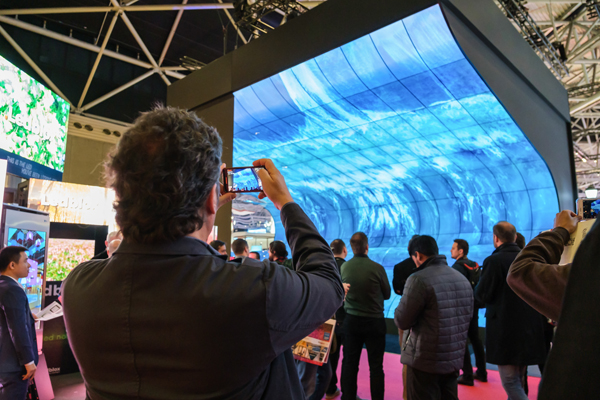The discussion about the need for bricks and mortar retailers to compete with online shopping by using digital signage to entice consumers into their stores and deliver them an improved experience once inside is now pretty much over. Few retailers today don’t “get it”, and some sort of signage is now widespread in almost every outlet.

“Retailers have recognised that effective use of digital signage is leading to increased customer engagement,” believes Jasmin Stemmler, product marketing manager, NEC Display Solutions Europe. “In a 2019 survey conducted by digitalsignagetoday.com, 64% of respondents cited customer engagement as a key benefit of their AV deployment, with improved customer service also very highly rated by 57%. Improved branding, increased upsell and cross-sell opportunities and increased uptake on coupons and promotions were also named as key benefits.”
But: the world is moving on. Online retail continues to up its game, and consumers have plenty of buying options. Just as importantly: while digital signage was once seen as a way of redressing the competitive balance between the high street and the web, it has moved on to a second phase where it is also about establishing competitive advantage over other retailers.
🏆
The 2024 Creative Retail Awards are open for entries.
The Creative Retail Awards are much more than a mere accolade; they represent the pinnacle of achievement in the retail industry. Garnering a nomination or winning one of these awards is a testament to innovation, excellence, and leadership.
www.creativeretailawards.com
Unique experience
“Many new technologies are being utilised in conjunction with digital signage for retail applications, and smart retailers can harness this technology to deliver a unique experience,” says Laila Hede Jensen, a board member of the Digital Signage Organisation (DSO), which aims to provide its members with a strong voice in the digital signage industry. “Augmented reality, artificial intelligence and facial recognition may not yet be standard on the high street, but the data-driven benefits provided will make retailers and digital signage manufacturers take note. For example, facial recognition software could recognise a previous customer as they enter the retail environment, signalling the in-store signage to display offers on products that suit the individual needs of the shopper. This is a true example of a value-added service; providing the consumer with a quicker, more personalised retail experience.”
Jeff Hastings, CEO of digital signage media player company BrightSign also seen rapid progress in the retail digital signage world.
“It seems that not long ago, touch displays were all the rage in terms of signage for retail,” he says. “Today, new technologies that were considered futuristic are being presented to retail customers. Smart cameras connected to digital signage can trigger appropriate on-screen content based on age and gender recognition. Voice control provides a new form of interaction with signage. Haptic technology is making the jump from gaming to retail displays triggering content via mid-air ‘touch’. In addition, AI has great potential to tune digital signage presentations in real time, collecting and analysing large quantities of data and automatically displaying environmentally-responsive content.”
Digital signage is also assuming an importance in retail that approaches mission-critical, and is no longer regarded as an addition to a retailer’s operations – but an integral part of them.
Return on investment
“The largest trend we are seeing from retailers is the ability to integrate signage into other technologies within the store,” notes Warren Bremner, business and channel development manager at Signagelive, developers of a cloud-based digital signage software platform. “This includes audience measurement and tracking, analytics, EPOS data, stock holding and also the ability to link their customers online and in-store experiences. Digital signage today is capable of being much better targeted, more relevant – and providing a real return on investment.”
“Consumers expect more than just functional stores,” believes Florian Rotberg, managing director of digital signage researcher and consultancy invidis consulting, and chairman of the Digital Signage Summit ISE 2020. “Retail experiences are becoming more important, and digital plays an integral role in delivering personalised, ever-surprising experiences at the point of sale. In addition, cross-channel shopping is becoming the new norm, meaning that retailers need to offer seamless user experiences – which is only possible with digital touchpoints and backend integration.”
Screens have, of course, long been the ‘face’ of digital signage – and here too, there are important developments as direct view, very fine pitch LED screens are supplanting the ubiquitous LCD screen bringing with them numerous advantages – not least in the creative ways in which they can be deployed.
The need for a complete digital retailing strategy, within a bricks and mortar environment, is clear. With the overwhelming amount of technology available to retailers, an event that combines hardware and software solutions with best practice use cases can prove to be vital in helping retailers plan for a store of the future, today.
ISE takes place 11-14 February 2020, at the RAI conference centre in Amsterdam. As the largest AV and systems integration event in the world, there is an entire hall dedicated to digital signage and DooH technologies (hall 8), as well as the half-day Digital Signage Summit ISE conference on 12 February at the nearby Hotel Okura. The combination of the comprehensive exhibition, with a strategy conference, will ensure attendees are best placed to gain an edge on competitors by forming a digital strategy.
Coming soon – part 2 of this industry feature.


















